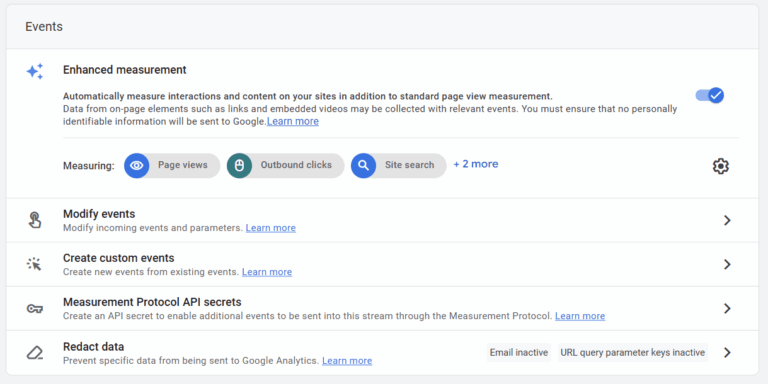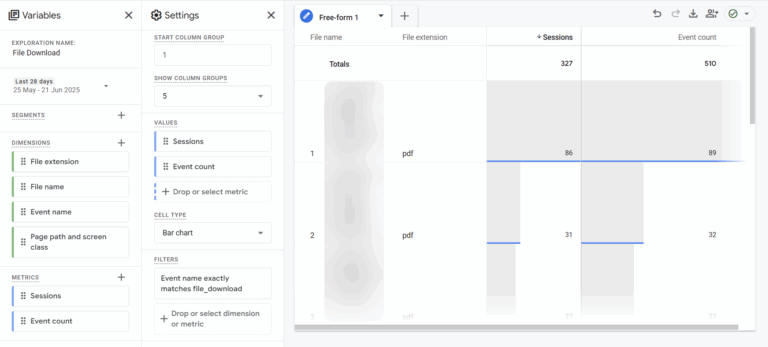
Exclude IP Addresses
Learn the simple, step-by-step process to exclude your team’s and office IP addresses in GA4.
Ever wondered how many times that crucial PDF report or engaging infographic has been downloaded from your website?
As a busy marketing manager or digital marketing freelancer, getting precise data on content performance is key, isn’t it?
So, why bother tracking file downloads, you ask? Well, frankly, it’s about understanding engagement beyond just page views.
A download signifies a deeper level of interest, a user actively seeking more information, perhaps even taking a step closer to conversion. Imagine you’ve created a fantastic lead magnet – a detailed e-book, for instance.
Knowing how many times it’s downloaded directly impacts your lead generation metrics. Without this data, you’re essentially flying blind on a significant chunk of your user’s journey.
file_download EventHere’s a bit of good news for you: if your GA4 setup uses enhanced measurement, you’ve likely got an automatic event called file_download already doing some heavy lifting in the background. Pretty neat, right? This event springs into action whenever someone downloads a PDF or another file type. And it doesn’t just tell you that a download happened; it comes packed with some super useful parameters, like:
file_extension: What type of file was it? (e.g., pdf, docx, xls)file_name: The actual name of the downloaded file.link_classes: Any CSS classes associated with the download link.link_text: The clickable text of the download link.These parameters are your secret sauce for getting granular with your data.
Enhanced measurement are in built tools within GA4 that allow you to track certain things without the use of a developer or advanced Google Tag Manager knowledge.
As well as the file download event mentioned above this includes:
and more.
Learn more about enhanced measurements from the Google crew here.
Head to your data stream – Admin > Data Collection and Modification > Data Streams.
From there, click on the toggle option where it says enhanced measurement.
You’ll want to ensure that file downloads are switched on.

Now, let’s get into the nitty-gritty of how to actually see this data in action. GA4’s Explorations are your best friend here. Think of them as custom reports where you can slice and dice your data to answer specific questions.
Here’s a step-by-step guide to setting up an exploration to track those precious downloads:
First off, head over to your GA4 property. On the left-hand navigation, you’ll find “Explorations.” Give that a click. You’ll then want to start a new “Free-form” exploration.
This is where you tell GA4 what information you want to look at. In the “Dimensions” section, click the plus sign and add the following:
File name: Crucial for identifying which file was downloaded.File extension: Handy if you want to see downloads for different file types.Event name: Essential for filtering down to just our file_download event.Page path: If you want to see where on your site the download happened, this is a great addition.Of course, you can choose what ever you want. But, if you want to filter on a extension or a page path, you’ll need to include it in the chart.
Next, for “Metrics,” you’ll want to add:
Event count: This is your primary metric, showing you exactly how many times each file has been downloaded.Sessions: While Event count is the main one, Sessions can give you context about how many distinct user sessions involved a download.Drag your chosen dimensions and metrics into the respective rows and columns sections of your exploration. For instance, File name often works well in “Rows,” and Event count in “Values.”
To focus specifically on file downloads, you’ll need to apply a filter. In the “Filters” section, click to add a new filter:
Event name.file_download.This ensures your exploration only shows data related to file downloads.
Want to get even more specific? Let’s say you’re only interested in a particular PDF. You can add another filter:
File name.my_awesome_report.pdf).And there you have it! This setup will show you precisely how many times that specific PDF has been downloaded within your chosen date range. It’s like having a dedicated download counter for each piece of content.

Sometimes, a file download isn’t just a download; it’s a micro-conversion, a significant step in your customer’s journey. Perhaps it’s a pricing guide, a detailed case study, or an application form. For these, you’ll want to mark them as conversions in GA4. The brilliant part? You don’t necessarily need Google Tag Manager (GTM) for this, though GTM certainly offers more advanced customisation if you ever need it.
Here’s how to do it directly in GA4:
In your GA4 interface, go to “Data display” and then “Events.”
Click on the “Create event” button. This allows you to define a new event based on existing ones.
You’ll set up a condition for when this new event should fire. For instance, to track a specific PDF download as a conversion:
pdf_download_report_q2 or pricing_guide_download.event_name “equals” file_downloadfile_extension “equals” pdf (if it’s a PDF)file_name “equals” your_specific_file.pdf (replace with the actual file name)Click “Create.” Now, whenever those conditions are met, your new custom event will be triggered.
Once your new custom event is created, go back to your “Events” list. You should see your newly created event there. On the right-hand side, there’s a toggle to “Mark as conversion.” Simply switch that on.
Voilà! You’ve just told GA4 that every time your specific PDF is downloaded, it counts as a conversion.
This will populate your conversion reports, allowing you to see its impact directly alongside your other key performance indicators.
It’s incredibly empowering for a marketing manager to see exactly which content pieces are contributing to your strategic goals, isn’t it?

Learn the simple, step-by-step process to exclude your team’s and office IP addresses in GA4.

Discover how to use the GA4 Path Exploration report to uncover insights into your website’s user behaviour.

Author
Hello, I'm Kyle Rushton McGregor!
I’m an experienced GA4 Specialist with a demonstrated history of working with Google Tag Manager and Looker Studio. I’m an international speaker who has trained 1000s of people on all things analytics.